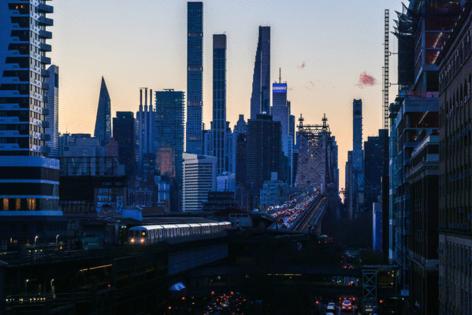Too many cubicles, too few homes spur incentives to convert offices to housing
Published in News & Features
HERNDON, Va. — Juan Ramirez, watching his dog play in Chandon Park here in suburban Virginia on a Saturday morning, tries to imagine the massive office buildings next to the park becoming apartments and townhouses.
“I guess it’s inevitable. People don’t use offices as much now. I hope it’s affordable. Maybe it’ll bring more young people to town, more taxes for parks,” said Ramirez, 38, who grew up in the area and returned recently to take a restaurant management job after living in Minnesota and Ohio.
Cities and suburbs around the country are struggling with vacant office space as remote work becomes an established post-pandemic reality. States are stepping in with tax breaks and zoning changes to help replace the unwanted cubicle farms with much-needed housing. In suburbs such as Herndon, the answer might be tearing down an office complex and replacing it with a residential building. In more urban environments it might mean renovating and retrofitting office buildings to create apartments.
“Office vacancy has climbed to a 30-year high and at the same time there’s a housing shortage. So naturally the question is, ‘Why can we not convert all these vacant office buildings into housing?’” said Jessica Morin, research director for CBRE, a commercial real estate firm. CBRE research shows converting offices to other uses, mostly housing, is set to peak this year at more than 20 million square feet, up from 6.3 million in 2021.
Some places that started conversions before the pandemic are leading the way: New York state and New York City changed their laws during a 1990s downturn to allow more office-to-apartment conversions in Manhattan, although now there’s a state vs. city standoff on zoning rules to convert newer offices.
Ohio, where interest in city living grew when Cleveland spruced up its downtown for the 2016 Republican convention, now has three cities — Cleveland, Cincinnati and Columbus — in the top 15 list for office conversions to housing, according to CBRE.
Nationwide, 119 office conversion projects, including for residential and other use, are under construction or were completed this year, the most since CBRE began tracking them in 2016. Those projects could add about 44,000 new housing units when completed.
Since 2016, projects representing 125 million square feet of offices have or are slated to be converted to other uses, usually to housing but sometimes to warehouses or laboratories. But despite the recent increase, that represents only about 2% of all U.S. office space.
Impediments to making apartments out of offices include the still-high value of office buildings in some downtown areas in cities such as San Francisco, and the cost of demolishing or refitting old office buildings with plumbing for individual kitchens and bathrooms. Many office buildings also lack windows with natural light, which apartment-dwellers often demand.
That’s why state incentives have played a large part, as well as streamlined zoning that makes project costs more predictable for developers. Some states are further along than others. A new California law allows residential “building by right” in office and other commercial zones, meaning developers don’t have to petition for a zoning change. Washington state passed a law last year requiring cities to ease zoning requirements for housing in existing commercial buildings. And an Arizona bill signed into law this month will allow larger cities to convert more commercial buildings into housing without zoning changes.
...continued
©2024 States Newsroom. Visit at stateline.org. Distributed by Tribune Content Agency, LLC.







Comments